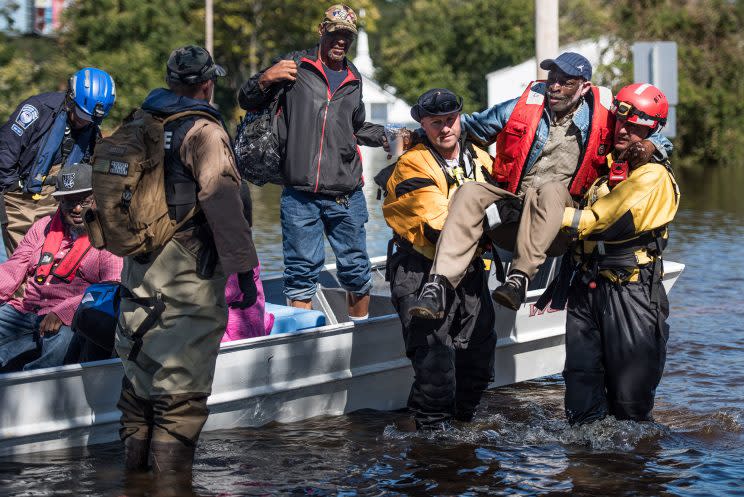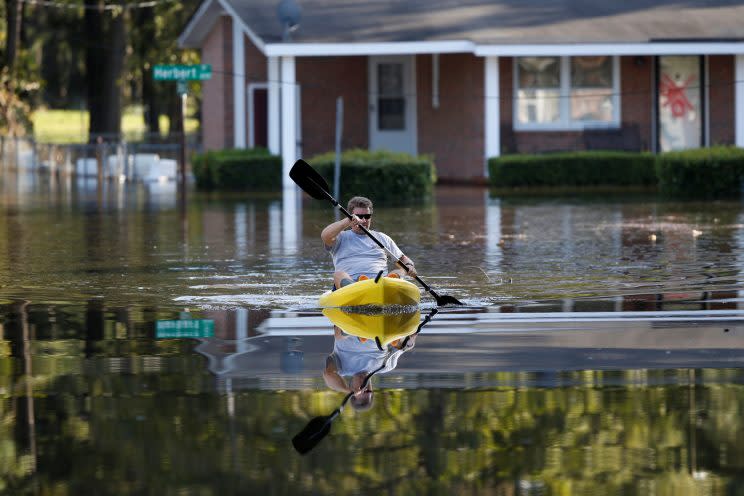Deadly floods hit North Carolina after Hurricane Matthew

Nearly a week after Hurricane Matthew barreled through the Caribbean and up the southeastern coast of the United States, floodwaters continue to rise along with the death toll in North Carolina.
As of Friday, floods had killed at more than 20 in North Carolina, approximately 2,300 others had been rescued, and 43 shelters were currently housing about 3,400 people throughout the state.
Gov. Pat McCrory implored people on Thursday to donate to the state’s disaster relief fund, emphasizing that “the poorest of the poor in North Carolina are the ones who are being hurt the most by these floods.”
According to the Food Bank of Central and Eastern North Carolina, approximately 356,000 residents in the 21 counties being monitored for storm damage were living without access to healthy food well before Matthew made its way up the east coast.
Slideshow: Hurricane Matthew batters the Southeast >>>
This week, rainwaters continued to rise and rivers overflowed into the streets of poverty-stricken communities like Lumberton, Goldsboro and Kinston, where residents anxiously braced for more flooding.
“I worked for years and years to make money for a double-wide, which I thought would be home for the rest of my life,” a retired Vietnam veteran named Wesley Turner told the New York Times of his mobile home in Kinston, which was on the verge of flooding. “I can’t afford another trailer. I can’t afford a pup tent.”
Floods are also wreaking havoc on North Carolina’s agriculture industry, a top contributor to the state’s economy.
According to the North Carolina Department of Agriculture and Consumer services, at least 1.8 million poultry birds have died in Matthew’s aftermath, though state Department Environmental Quality Secretary Donald van der Vaart estimated that the total number of poultry killed in the floods could be closer to 5 million.
“Knock on wood, right now we don’t have the kind of catastrophic losses we had in 1999,” van der Vaart told Reuters, referring to the floods that overflowed many of the state’s hog farms during Hurricane Floyd, carrying animal waste and carcasses into local waterways.
While van der Vaart said that the recent flooding had overwhelmed pits filled with hog waste on some farms in the state, he predicted that the waste would be “vastly diluted” by the floodwaters, causing little environmental damage.

In 1999, Hurricane Floyd caused extensive damage to Princeville, N.C., regarded as one of the nation’s first towns settled by freed African-Americans. Days after Matthew receded in the Atlantic, floodwaters began to inundate the historic town of 2,000 once more.
On Wednesday, officials in Princeville’s Edgecombe County reported that water was “ankle-deep” in one part of town.
As of Thursday, the nearby Tar River had risen to 36.3 feet. Roads and bridges entering the town had been blocked off, leaving evacuated residents stranded across the river in Tarboro, N.C., as the water inches dangerously close to the 37-foot dike that protects Princeville from the swollen river.
Speaking to the Washington Post Thursday, one evacuated resident described the situation as “another nightmare.”
“We’re going to have a lot of work to do,” McCrory told reporters regarding Princeville on Thursday. “We’re going to have to rebuild a town.”
The governor also announced that statewide power outages had been reduced significantly from a high of almost 900,000 last week to approximately 55,000.

Ahead of additional flooding expected over the weekend, state and federal officials warned North Carolinians of the potential health hazards they might encounter upon returning to their flooded homes or workplaces.
“Although most floods do not cause serious outbreaks of infectious disease or chemical poisonings, they can cause sickness in workers and others who come in contact with contaminated floodwater,” officials with the U.S. Department of Labor advised. “In addition, flooded areas may contain electrical or fire hazards connected with downed power lines.”
Hundreds of FEMA workers and over 1,000 National Guard troops have been deployed throughout the state since the hurricane began. According to the governor’s office, the storm’s total damage to the state is still being assessed.



